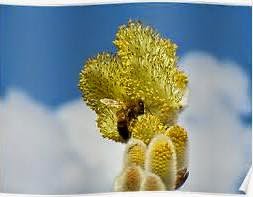 |
| Grey Willow |
 |
| Yellow (Mature) Pussy Willows |
 |
| Silkie-woman Transforming |
I was a very polite little girl….
Silkies are one of the shapeshifting sea-folk; when they’re in the ocean, they look like seals, but when they come out on land, they can take off their pelts and look like beautiful humans as they dance in the moonlight.
For the last 23 years at the Ligonier Highland Games, I’ve traditionally begun my set of Scottish tales with a new silkie tale, because I love them so much. My granny told me several, and I’ve collected others over the years; I have about 38 in my repertoire. Besides, it’s fun to use my harp seal puppy puppet, Saltie! People always want to pet her afterwards.
I love silkie songs too, from the old ballads like “The Great Selkie of Sule Skerry,” “The Fisherman’s Song for Attracting the Seals,” and “The Seal-Woman’s Croon,” a Hebridean lullaby that’s among my very early memories. Absolutely, one of my favorite albums is Christina Tourin’s The Harp Seal Lullaby CD, which has several seal songs on it.
It’s said that if you put a willow twig under your pillow, you may have magical dreams—perhaps of the silkies!




Silkies sound very cool. They are benevolent creatures I take it?
ReplyDeleteThey are! And one of my favorite kinds of faery folk! The usual warning about the faery folk, "If you dae them a favor, they will reward you, BUT if you mak' them angry, they WILL hae their revenge sevenfold!" certainly applies to them. There's an Irish selchie tale about a little boy who finds a lost seal pup and brings it home. That night, a very angry bull seal arrives, wakening the housefhold with his loud demands for the return of his son. The boy's father, who'd already told his son he couldn't keep a wild creature later than the dawn, brings the pup out. Later, unable to go to a market in another town, due to oversleeping and missing the boat, in payment, the bull takes him invisibly on his back upriver, then changes to man-form to have a drink with him at the pub. OTOH, "The Silkie's Revenge" that I mentioned in the post is about a minister who hates seals because they damage his nets (not enough to live on, being a minister in a poor parish). One morning he finds a baby seal tangled in his net. Not one single fish nor one mesh have been damaged, but he kills the pup anyway, in the sight of its mother. With this cruel act, his luck departs. Several months later, his wife dead, he hires a stranger to be his housekeeper and take care of his little girl. In the end, the housekeeper turns out to be the pup's mother, and she has her revenge. Be polite and kind! Thanks for your comment!
ReplyDeletechenlina20160416
ReplyDeletejordan 11 concord
ray ban sunglasses outlet
adidas originals
burberry outlet
burberry scarf
toms shoes outlet online
ralph lauren outlet
instyler max
louis vuitton outlet
louis vuitton outlet stores
tory burch outlet
michael kors handbags
timberland outlet
coach factorty outlet online
nike air huarache
nike air max
kate spade handbags
air huarache
christian louboutin outlet
timberland outlet
adidas superstar
michael kors
gucci outlet
michael kors
michael kors outlet
nike roshe runs
canada goose jackets
kobe bryant shoes
tiffany outlet
kd 8 shoes
oakley vault
nike air max 90
ed hardy clothing
north face outlet
ugg outlet
louis vuitton outlet
louis vuitton outlet
tory burch handbags
coach outlet
air jordans
as
yeezy boost 350
ReplyDeletekd 12
moncler jacket
moncler jackets
golden goose
kyrie 6
jordan sneakers
supreme clothing
moncler outlet
curry 6